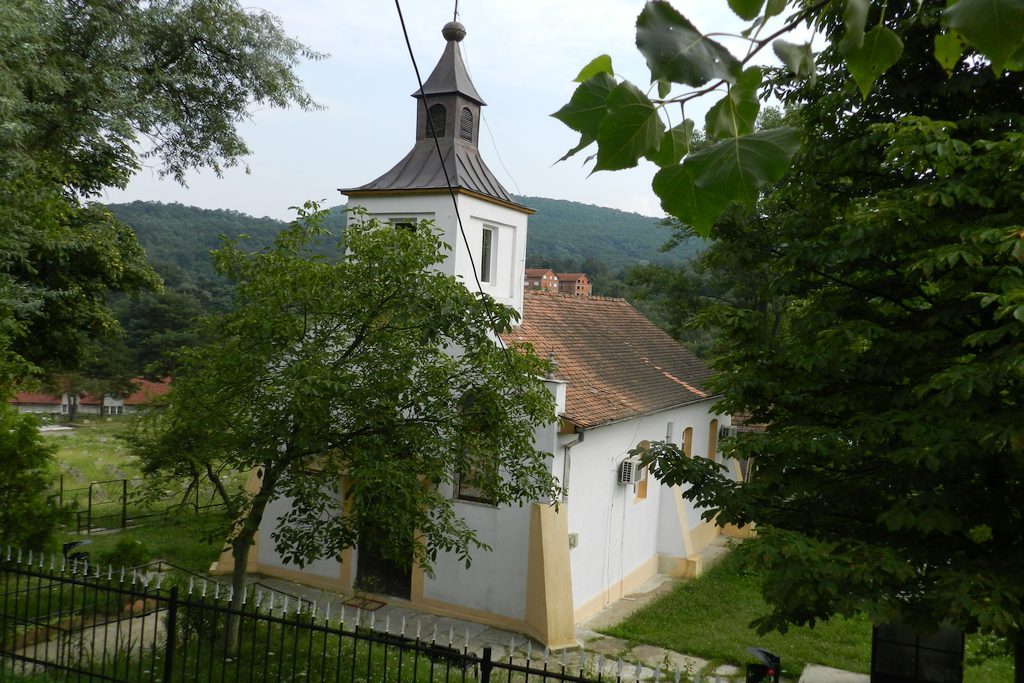

Within the suburban churches from Orșova, it was also found in the past the church from the commune Jupalnic. As it stands out from the old maps of Orșova, the commune Jupalnic was situated at 1, 5 km towards North from the old Orșova.
The church from here was built up through the efforts of the Christians in the year 1827, as it comes out from the notation of the Priest Ștefan Boldea, situated on an old Ritual, kept today at the Episcopacy of the Severin and Strehaia. The existent documents in the archive of the congregation certify this church in the year 1830.
In the same manner as at the Church of Orșova, the architectonic style was the same one of a nave with a semicircular apse at the altar and the tower positioned above the entrance in the narthex. As construction material, there was used the burned brick and stone, and for the roof, shingles, the tower being covered with plates. Inside, the church was boarded with an ornamental mosaic with flowers, of which there was only kept a part, with which the altar of the new church was boarded. The painting of the old church from Jupalnic was executed by the painter Vartolomei Deliominic from Caransebeș, in the year 1922, during the times of the priest Pavel Magdescu (senior).
As it comes out from the notation of Mister Iancu Seracovan, the singer of the church from Jupalnic, in 1964 there were celebrated 100 years from the inauguration of the tower of this church. Until 1864, it didn’t have a tower with a bell tower, the two bells being hanged during this whole time by two wooden piers. The two bells were served to the congregation Jupalnic until 1906.
The existent information about the priests of the congregation Jupalnic are as poor as in the case of the other churches from Orșova. This is because of the fact that historians were firstly interested by the exposal of the activity of the superior organs of the church, the activity of the congregation being left in the guidance of the congregation priests, who, either because of negligence, or because of the unsettled periods they couldn’t make it known to the posterity. In this sense, about the priest Ioan Popovici we know quite a few and namely the fact that the priestess was caught by the Turks and taken as prisoner. We also know the fact that he left by foot from the village Rudăria (situated somewhere in the area of the old Eșelnița), coming from the protopope Nicolae Stoica from Hațeg, who was a good friend and advisor for him. He lived in his house for a period because of the fact that following the events from 1787 – 1792, Jupalnic was abandoned.
About the descendant of Ioan Popovici, Petru Popovici, we only know the fact that by 1790 he was accused at Rudăria because of the fact that he had been three times in Wallachia without the approval from the civil and church organs.
The priest Pavel Magdescu – Senior was part of the National Romanian Council, which chose members for the Great National Assembly of 1918. He was chosen as member of this council on the 25th of November 1918. Concerning the priest Magdescu there appear the documents from that period Spiridon Șandru the Former priest of Jupalnic, who was succeede by Magdescu. The two participated on the 14th / 27th of November 1918 at the Gathering of the monastic Cosistor of the Episcopacy.
Currently, the clerical command of the congregation is in the hands of a restless servant of the Holy altar, the priest Nicolae Jinga.
